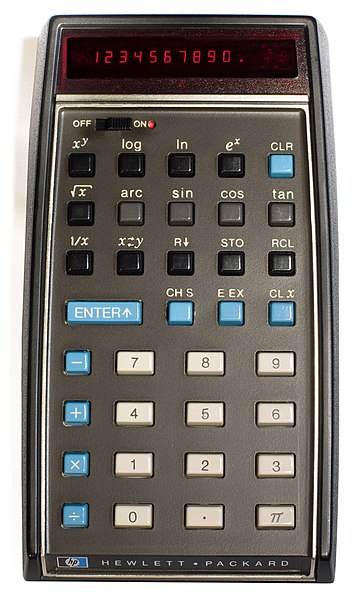
The image above is from Wikimedia Commons, licensed under the Creative Commons Attribution Share-Alike 4.0 International License, and is thus available for your use under the same terms.
Its author is Mister rf.
In accordance with Moore's Law, as time went on, it became possible to put more transistors on a single chip and make it do more things.
So when once people were suitably amazed that one could get four NAND gates on a single chip, it became possible to put 64 bits of high speed memory on one chip, or a four-bit wide arithmetic-logic unit on one chip.
 |
The image above is from Wikimedia Commons, licensed under the Creative Commons Attribution Share-Alike 4.0 International License, and is thus available for your use under the same terms. Its author is Mister rf. |
That something weird and wonderful was in the wind had perhaps already been apparent for some time when something happened to make it unmistakably obvious, on the first day of February in 1972. That was the day when Hewlett-Packard announced the HP-35 pocket calculator, pictured at right.
It fit in your pocket and ran on batteries. It calculated trignometric functions and logarithms to ten places of accuracy. And it cost $395.
One can see from the photograph reproduced there that, at first, putting legends on the keys for such advanced functions as "sin", "cos", and "tan" was something that Hewlett-Packard appeard initially hesitant to do; of course, this was more likely because they wanted to avoid delays in making the product available than because they thought that scientific pocket calculators would be a passing fad.
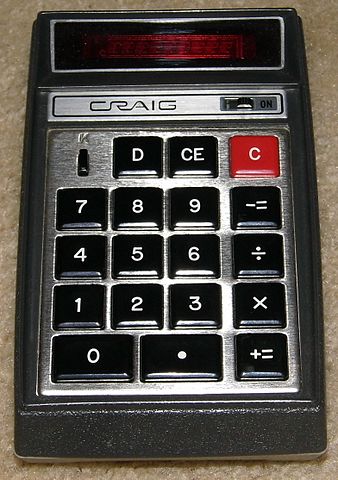 |
The image above is from Wikimedia Commons, licensed under the Creative Commons Attribution Share-Alike 2.0 Generic License, and is thus available for your use under the same terms. Its author is Joe Haupt. |
Or perhaps it became unmistakably obvious a little earlier, in September 1971. That was when Bowmar came out with the 901B, one of the earliest pocket calculators - the first American-made one, but preceded by at least one from Busicom in Japan. Pictured at left is the Craig 4501, a rebadged version of it.
The Klixon keyboard of this calculator, and its microchip, were both made by Texas Instruments.
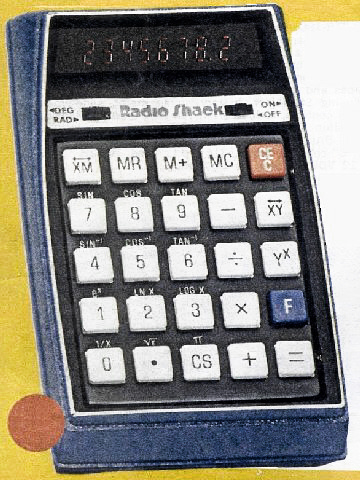
The image at left shows the Radio Shack EC-450 calculator. This was a rebadged version of the Bowmar MX-100 calculator, another one which came out before the Texas Instruments SR-50, and which was then swiftly eclipsed by it. Bowmar was an early manufacturer of calculators, mostly four-function calculators, but while their calculators were popular for a time, they failed to navigate the rapidly changing calculator market, and ended up filing for bankruptcy in 1975.
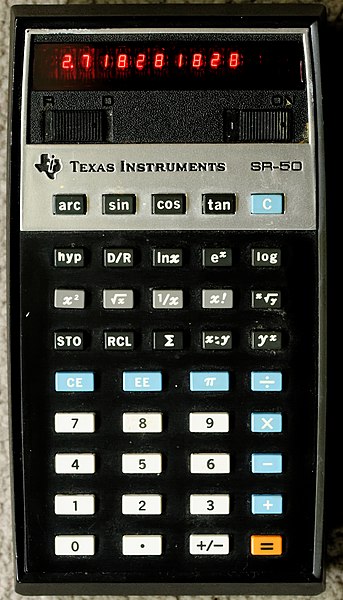 |
The image above is from Wikimedia Commons, licensed under the Creative Commons Attribution Share-Alike International License, and is thus available for your use under the same terms. Its author is Jud McCrainie. |
In 1974, however, the Texas Instruments SR-50 came out, for only $170, and you didn't have to learn RPN to use it, which is pictured at right.
The Bowmar MX-100 calculator displayed results with eight digits of precision, but the log and trig functions only gave results to six digits of precision. As well, the calculator did not have scientific notation. Thus, while it was cheaper than the HP-35, it was also clearly inferior to it.
The Texas Instruments SR-50, on the other hand, was clearly the equal of the HP-35 in power and functionality, and therefore it was a major step forward in the affordability of scientific pocket calculators.
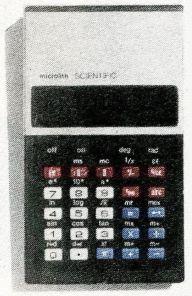
Shortly after the Texas Instruments SR-50 became available, though, you could get a scientific calculator for as little as $25. One such calculator was the Microlith scientific (model 205, though that was just in small print on the back). It only calculated to 8 digit accuracy, with trig and log functions calculated only to 6 digits. It used a green vacuum fluorescent display instead of LEDs. That was a discounted price; it came out at a higher price when first introduced. To the right of this paragraph is an image I have retouched and colorized, based on a black-and-white image in an advertisement, of this calculator; due to the poor quality of the result, I also reduced it considerably in size.
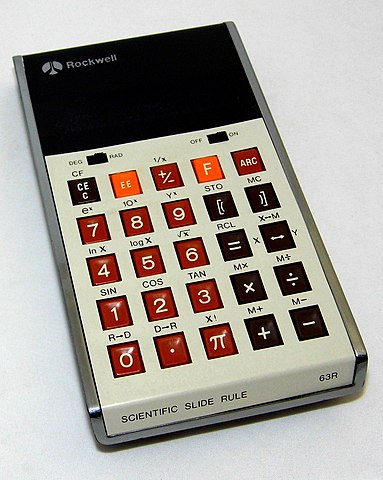 |
The image above is from Wikimedia Commons, licensed under the Creative Commons Attribution Share-Alike 2.0 Generic License, and is thus available for your use under the same terms. Its author is Joe Haupt. |
This calculator was made in Hong Kong, and appears to have used the same calculator chip as the Rockwell 63R scientific calculator - which was instead assembled in Mexico. As a high-quality image of that calculator was available to me, I present it to the left of this paragraph. Rockwell, along with MOS Technology, were the earliest companies to make chips allowing single-chip pocket calculators to be constructed, and this led to much lower prices for pocket calculators.
While the color scheme of the buttons on the Rockwell 63R calculator is very different from that of the Microlith 205, the arrangement of the buttons is very similar; the only changes are in the top two rows. Thus, the top row of the Rockwell keyboard has these keys: C/CE, EE, +/-, F, and arc, and the second row, after the number keys, 7, 8, and 9, has [(, )], The Microlith, on the other hand, has those keys in this order: EE, [(, )], +/-, C/CE on the top row, and on the second row, after the number keys, 7, 8, and 9, there are F(m) and arc. (The F(m) key on the Microlith 205 performs exactly the same function as the F key on the Rockwell 63R; its designation on the Microlith 205 is presumably intented to acknowledge that in addition to shifting 1, 2, and 3 to the functions sin, cos, and tan, it also shifts the +, -, × and ÷ keys to the corresponding operations with the memory.)
Although the two calculators used the same calculator chip, their construction is a study in contrasts: the case of the Microlith calculator is plastic, with a decorative metal covering on the top, while that of the Rockwell calculator is metal; also, the keys of the Microlith character have their legends molded as indentations to the keys, into which paint is applied; whereas the keys of the Rockwell calculator are of a harder, higher-quality plastic, and are double-shot molded. Perhaps this is why, after increased competition in the calculator market also led to the Rockwell calculator, originally introduced at $99.95, to have its remaining stocks sold at a much lower price, it only fell to a discounted price of $40.
Although the calculator had its limitations, it did nicely fit all the important functions needed for a scientific calculator nicely into only 25 keys.
The Rockwell 63R was rebadged and sold as the EC-490 by Radio Shack.
The advertisement shown below appeared in a number of magazines for electronics engineers in November, 1974:

The fact that everything needed for a pocket calculator's electronics could be put on a single chip, of course, implied that the price of scientific calculators was about to come down. Note that at the time of this advertisement, MOS Technology was owned by Allen-Bradley, a company famous for its potentiometers and industrial switches, and had not yet been bought by Commodore, a company that first (or, rather, previously; at one time, they even sold portable typewriters) made calculators, and then switched to computers with the PET.
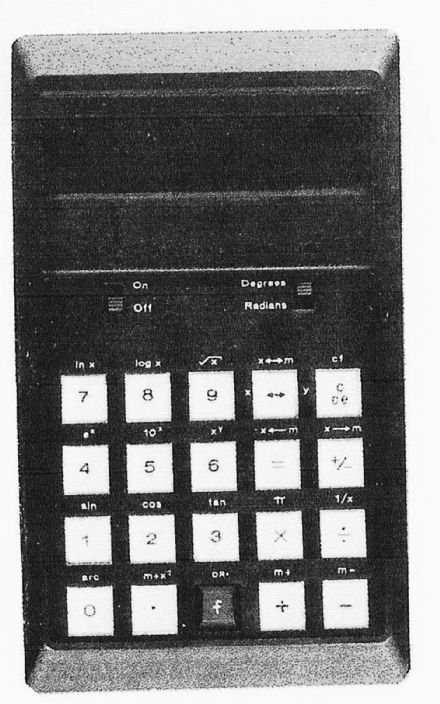
The later Bowmar MX-140 scientific calculator was an example of a calculator built with the 2529-001 chip, which allowed a scientific calculator to be made with only 20 keys. This was not even unique; there was also a scientific calculator available about a year previously from Sears that had only 20 keys, in a different arrangement, pictured at left.
Incidentally, it is interesting that the Sears calculator manages to include, as the shifted function of the decimal point, m + x2, as that is useful in calculating things like standard deviations, without adding a large number of specialized functions to the calculator.
While the MX-140 went down to 20 keys by having two function keys (which, of course, isn't terribly unusual for calculators with many more buttons), this one has only one "f" key used to shift the keys, but the shift of the zero is "arc". From page 22 of the manual for that calculator, which is available online, I see that one does an arcsine by pressing [f][0][1] and not, as one might have feared, [f][0][f][1] in order to press [arc] and then [sin], so once again it gets points for being well designed. Since, however, like the Microlith 205 mentioned above, its precision is limited, and its display is vacuum fluorescent, these things are not sufficient to avoid it being dismissed as being vastly inferior to the serious characters from the likes of Texas Instruments and Hewlett-Packard. And, in addition, it lacks one thing that even the Bowmar MX-140 did have (even if the Bowmar MX-100 also lacked it): there is no enter exponent function, and indeed it does not have scientific notation.
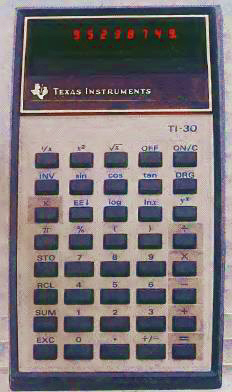
June 13, 1976 was the day on which the TI-30, pictured at right, was introduced at an MSRP of $24.95; one web site gives that as the official day of the 'death' of the slide rule, and another candidate might be July 11, 1976, when Keuffel & Esser made their last slide rule, to send it to the Smithsonian Institution.
The Bowmar MX-100 calculator was too expensive at its introduction to mark the end of the slide rule, but its capabilities, although inferior to those of the SR-50, would have been sufficient to eclipse the slide rule. Thus, when similar calculators, like the Microlith 205 mentioned above, became available at heavily discounted prices, before the TI-30, I would be inclined to say the fate of the slide rule was sealed, and this happened in the latter part of 1975.
The TI-30 used a 9-volt battery rather than using the rechargable battery module found in the SR-50 and other high-end Texas Instruments calculators. Wikipedia notes that the SR-40, which preceded the TI-30, was identical to it in functionality, but the SR-40 also used the usual Texas Instruments rechargeable battery module. While the TI-30 had an EE key and scientific notation, it too only had an 8-digit display, and thus when scientific notation was in effect, it could only display five digits, like the Microlith 305, so it was more than the lack of hyperbolic functions that distinguished it from the SR-50. At least it had a LED display, unlike the vacuum fluorescent display of the Microlith 305 and other cheap calculators. Also unlike the cheaper calculators, it did calculate log and trig functions to its full 8-digit precision.
If a single chip could calculate log and trig functions, it ought to be possible for a single chip to perform just basic arithmetic along with control functions to step through a program, which would not seem to be more complicated. However, memory was still expensive; as well, speed wasn't a critical issue in a pocket calculator, which could do its calculations one decimal digit at a time.
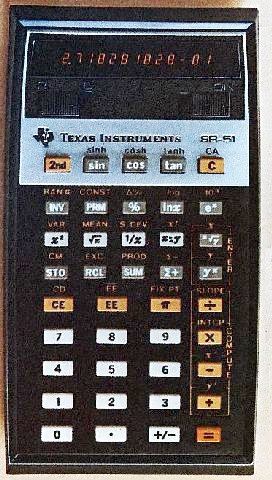
Pictured at right is another one of the earliest scientific calculators from Texas Instruments, the later SR-51, which, like the HP-45, included some additional functions.
Interestingly, to provide a less-expensive option, Texas Instruments also made the SR-16 calculator, which had scientific notation, and logarithmic and exponential functions, but not trig functions. The manual provided formulas with which trignometric functions could be approximated if desired.
A number of Wang desktop calculators also had that function set, and many business/financial calculators, while not providing trigonometric functions, which would be irrelevant, also provided logarithmic and exponential functions, since these were the building blocks of the functions for interest rate calculations that they also provided. However, as far as I am aware, the SR-16 is unique among handheld calculators that don't also support some specialized function set.
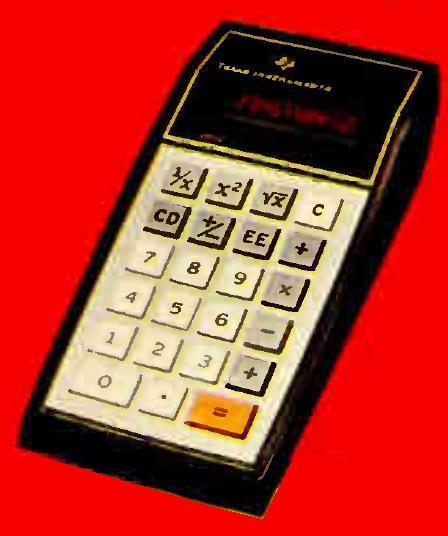
The SR-16 was contemporary with the SR-50; the SR-10, pictured at right, on the other hand, came out earlier than the HP-35; it had scientific notation in addition to square roots, and so some people have credited Texas Instruments instead of Hewlett-Packard for making the first scientific calculator. While I am not inclined to agree with that viewpoint, I will note that the SR-10 was of solid quality construction; of course, in a way, that is a consequence of the fact that, at the early date of its introduction, the electronics in a calculator was still quite expensive, and so it only made sense to put that electronics in a package of corresponding quality.
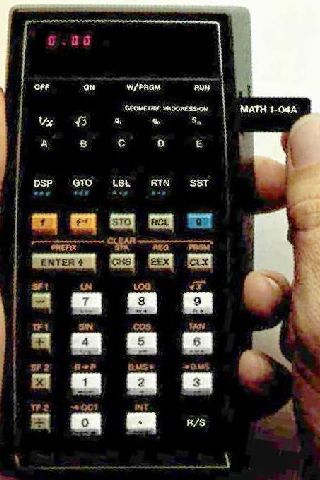
Hewlett-Packard didn't sit on its laurels, though; even as other companies came out with much cheaper rivals to the HP-35, they came out with the HP-65, pictured at left. Not only was it programmable - including with conditional branch instructions - but it could save programs on small magnetic cards.
This calculator was originally announced in the May 1974 issue of the Hewlett-Packard Journal. Initially, it sold for a price of $795.
A little over a year later, on September 16, 1975, the Texas Instruments SR-52 came out as a cheaper rival at a price of $395; however, it was a bit too fat to fit in most pockets, although you wouldn't know it from the photos in the earlier advertisements. It wasn't until the TI-59 came out in 1977 that Texas Instruments had a magnetic card calculator that was sufficiently svelte to conform to the common notion of what constituted a pocket calculator.
However, this wasn't because Texas Instruments was using less sophisticated electronics; the SR-52 only had a single board of electronic components, but its case was large because of the size of the electric motor used in the magnetic card reader to move the card at a uniform speed past the magnetic read/write head. So it was only in that respect that they were technically behind Hewlett-Packard.
The HP-65 had a 100-step memory, while the SR-52 had a 224-step memory. However, unlike Hewlett-Packard programmable calculators, TI programmable calculators did not have "merged keystrokes"; except for the "2nd" key, program steps entered using multiple keystrokes occupied multiple locations in storage. Thus, the fact that the HP-67 also had memory for 224 program steps made it appear that it had the same program capacity as the SR-52, when, in fact, its program capacity was larger; I have to think that was a very bad marketing decision on the part of Hewlett-Packard. When Texas Instruments came out with the TI-59 in May 1977, it had 960 steps of program memory, and even the TI-58, which was similar in appearance, but did not include a magnetic card reader, had 480 steps.
The TI-59 remedied one omission of the SR-52; the earlier calculator didn't have an INT or FRAC function, allowing one to take the integer or fractional part of a number, which can be very useful in some kinds of programs. The HP-65 didn't make that mistake. However, there was a workaround involving the degrees-minutes-seconds conversion function of the SR-52.
Another difference in how Texas Instruments and Hewlett-Packard approached their calculators is illustrated in the ways they chose to provide a printing capability. Along with the SR-52 and SR-56 calculators, Texas Instruments made the PC-100 print cradle into which one of those calculators could be mounted; later, when they came out with the TI-58 and TI-59 calculators, they introduced a modified version, the PC-100A, shown at right, which worked with the SR-52, the SR-56, and the TI-58 and TI-59.
Hewlett-Packard, on the other hand, simply offered, as shown below, the HP 97 calculator, an alternate, larger model of the HP 67 magnetic card programmable, with a built-in printer.
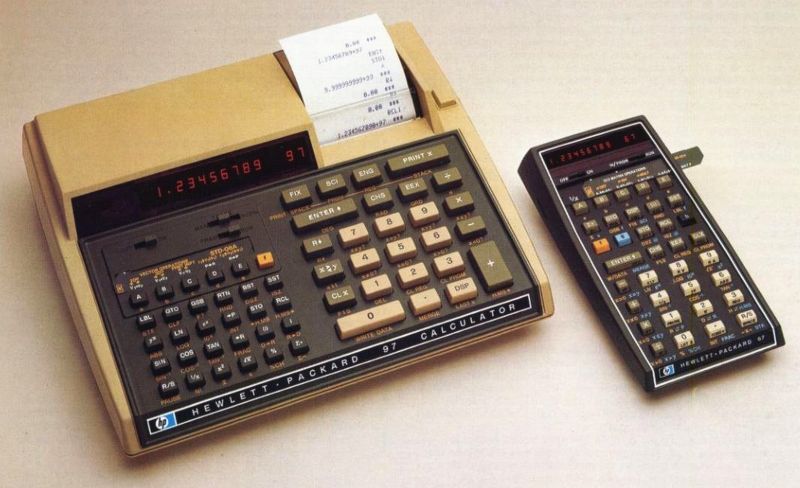
This, of course, meant one had to make a more difficult choice in the beginning, involving spending more money, but the result was a more compact unit if you chose printing.
Casio made a little-known (at least in North America) calculator, the Casio Pro fx-1, not to be confused with an earlier desktop scientific calculator of theirs also called the fx-1, and the Casio Pro fx-1 also used magnetic cards; however, they were plastic cards with a magnetic stripe, and there were timing marks molded into the plastic, so that you would move a card through the calculator by hand to record or load programs. And this calculator came out in September 1977, so it wasn't a contemporary of the HP-65 or the SR-52. Presumably, eliminating the need for a motor to move the cards through the calculator let them offer this capability at a lower price.
Amazingly, they don't seem to make pocket calculators today that let you plug in a USB stick on which to save programs; but then, in general, the capabilities of pocket calculators today appear to be strongly constrained by the need to meet the criteria for students to be allowed to use those calculators during exams.
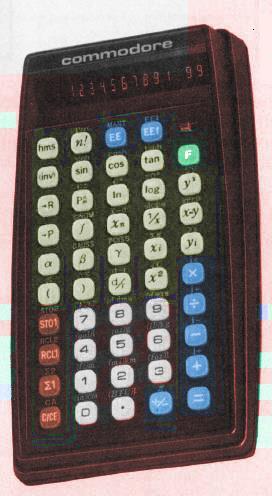
Incidentally, I am quite fond of the color scheme used with the original SR-50 calculator, or with the calculator shown at right, the Commodore SR 4190R calculator. The image at right is a black-and-white image I found in an advertisement which I have crudely colorized myself, incidentally, so I must apologize for its relatively poor quality.
This calculator was an attempt to take calculators like the HP-45 and SR-51, and go one better; it had 49 buttons, and a host of functions even including the gamma function. I had thought that it was the only pocket calculator to ever include the gamma function, but in fact, there were a few others, but they were much more obscure than this relatively popular model.
Aside from the wide array of functions, the SR 4190R calculator had a LED display which could show ten-digit precision and a two-digit exponent at the same time, and a rechargeable battery, thus it established its right to be taken seriously beside the alternatives from Texas Instruments and Hewlett-Packard, unlike most of the other calculators from other companies at that time. In fact, it even went the LED displays of other calculators one better, by using slightly smaller digits for the exponent!
Below is a comparison of two similar advertisements, the first showing the SR-50 and SR-51 calculators, and the second showing the SR-50A and SR-51A calculators, so that their color schemes can be compared.
Incidentally, not to be confused with the SR-51A, much later there was also an SR-51 II. This had a different layout of buttons from that of the SR-51.

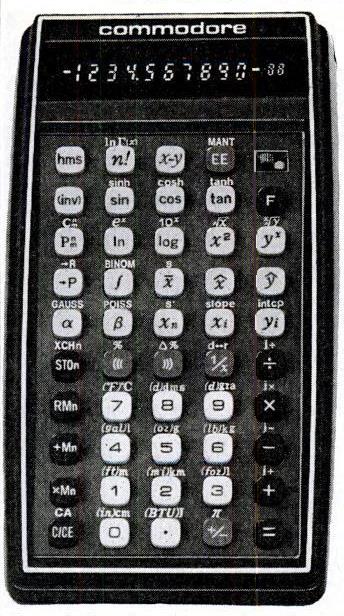
However, just as the SR-50 was followed by the SR-50A with a more subdued color scheme, when the Commodore SR 4190R was followed by a modified version, the SR 9190R, where the gamma function was replaced by the log of the gamma function to increase its range, its successor also had a color scheme that was more subdued; in its case, built around white, grey, and black... and thus I felt no need to attempt to colorize the black and white photo of that calculator I found from another advertisement which I present at left.

In addition to their basic scientific calculator, the HP-35, Hewlett-Packard, as noted above, also made the HP-45 with additional built-in mathematical functions, and the HP-65, which could save programs on magnetic cards. They also made the HP-55 as well, which provided programmability without the expensive feature of a magnetic card reader.
Similarly, Texas Instruments introduced the SR-56 calculator, a programmable calculator with 100 program steps, but without a magnetic card reader, at the same time as the SR-52. It was interesting for another reason; it was their last calculator to have only four keys in the rows of the calculator keyboard which contained the digit keys, so that they could be spaced more widely; the SR-52, although it still used wider keys for the digits, had five keys in every row, and subsequent calculators from Texas Instruments of all types followed suit (until much later, where the practice, apparently introduced by Japanese-made calculators, of having six keys in at least some rows was followed.) Thus, I've included an image of the SR-56, from an advertisement that also featured the SR-52 and the PC-100A print cradle, at right.
Later on, when the TI-59 replaced the SR-52, it was accompanied by both the TI-58, with 480 steps, without a magnetic card reader, but otherwise substantially similar to the TI-59, but also by the TI-57 programmable, with 50 steps, and the TI-55 which was similar to the SR-51 in the functions that it offered, but which (unlike the very similar SR-51 II) also offered a very limited 32-step programming capability (without the ability to perform conditional branches).
Before the HP-35, there had been electronic calculators capable of log and trig functions that could sit on top of a desk for some time.
The Wang Laboratories LOCI-2, from 1965, was a programmable calculator that could calculate logarithms in addition to doing arithmetical functions. The Wang 320 KT and 320 KR provided trigonometric functions in degrees and radians respectively, but they were calculated by built-in programs in the same programming instruction set that the calculator presented to the user, so calculating the value of a trig function could take as much as ten seconds.
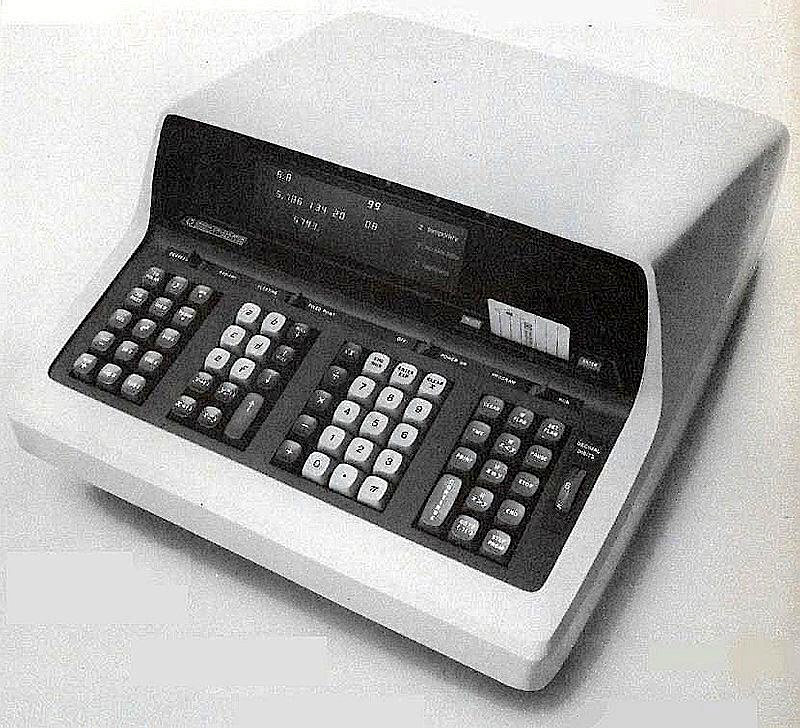
The Hewlett-Packard 9100A, introduced in March, 1968, was a programmable scientific calculator of relatively compact size and impressive capabilities. It offered log and trig functions, and the trig functions were in the same microcode as was used to implement the calculator's other basic functions, calculated using the rapid CORDIC algorithm. Thus, despite being constructed from discrete transistors, it was the first electronic programmable calculator that was basically comparable to an advanced scientific programmable calculator such as the HP-65 or the SR-52... those two being chosen as examples because the 9100A could save programs, and load them back in again, from magnetic cards as well.
Soon after, the 9100B offered a larger memory capacity, and provided one very useful additional function for transferring numbers between the display and the memory.
It is interesting that such an electronic miracle as the Hewlett-Packard 9100A, a programmable scientific calculator that was in a compact package that could sit on a desktop, was available only a little more than a year before July 20, 1969, and the IBM System/360 Model 195, a computer that combined both cache memory (previously introduced on the Model 85) and full out-of-order execution (previously introduced on the Model 91) was announced on August 20, 1969, just a month after.
Sometimes we are told that we can thank the Apollo space program for the existence of advanced integrated circuits today, but as previously noted, the real story is more complicated than that. However, that isn't entirely relevant to the HP 9100A; to avoid causing confusion, I must hasten to add that like the PDP-8/S, this calculator was made from discrete transistors, and did not benefit from the increased compactness of integrated circuits.
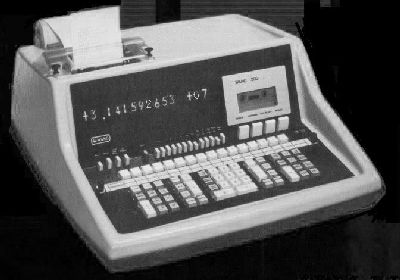
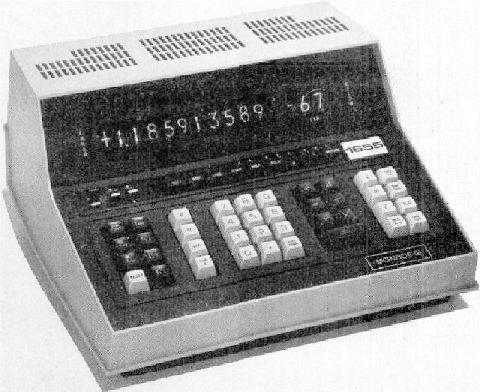
Other competitors came along later, such as the Wang 500 calculator, pictured at right, from 1971 and the Monroe 1655, pictured at left, (among several different models with different capabilities) from 1970.
The Wang 500 could save programs on cassette tapes with a built-in digital cassette drive; the Monroe 1655 could have an optional card reader attached.
The cards which the Monroe 1655 could read had the same dimensions as a standard IBM 80-column punched card, and they were in a related format also devised originally by IBM. An IBM Port-a-Punch, introduced by IBM in 1958, allowed a 40 column card to be prepared in the field without a keypunch machine. The Port-a-Punch provided a framework allowing a stylus to punch out holes in special cards where the possible locations for holes were all scored in advance.
The Monroe 1655 was slower in operation than the Wang 500, and it had the limitation that the "2nd Func" key did not work as a shift key; instead, for example, the SIN COS key caused both the sine and cosine to be calculated: the sine was displayed, and the cosine was stored in register 9: the "2nd Func" key recalled the contents of register 9. However, the Monroe 1655 used normal algebraic entry for the basic arithmetic functions.
The Wang 500 did basic arithmetic functions in a simplistic fashion, which someone once described as "RPN with no stack". It made up for this by having two sets of buttons for arithmetic functions, one to the left of the numeric keypad as well as one to the right; they used registers 14 and 15, respectively, as the secondary register, so one could occasionally use the left-hand keys to enable the saving of intermediate results, as a substitute for not having either a stack or algebraic entry for parenthesis keys.
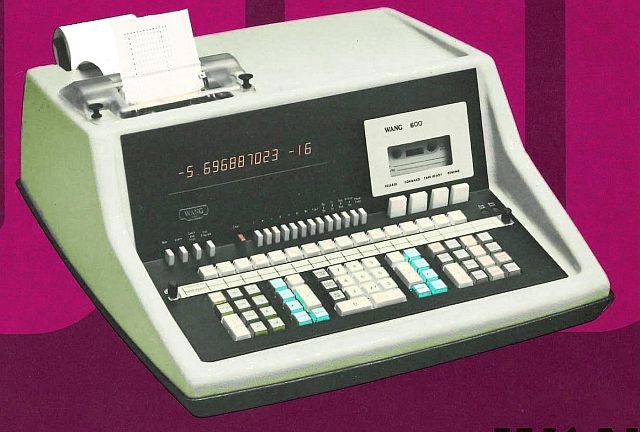
The Wang 500 had two successors, the Wang 520 and the Wang 600, which were very similar in appearance. The Wang 520 added an INDIR key, which let one use a number as an index to a register. Memory capacity options were also increased. The Wang 600 added additional keys to facilitate performing I/O to attached devices, and replaced the Nixie tubes with an LED display. An image of a Wang 600 appears at right; it is from the front of a brochure; this was a black-and-white image, which I have attempted to colorize. (While the photograph on the front of the brochure was in black and white, the purple color of the background was present on the original brochure itself.)
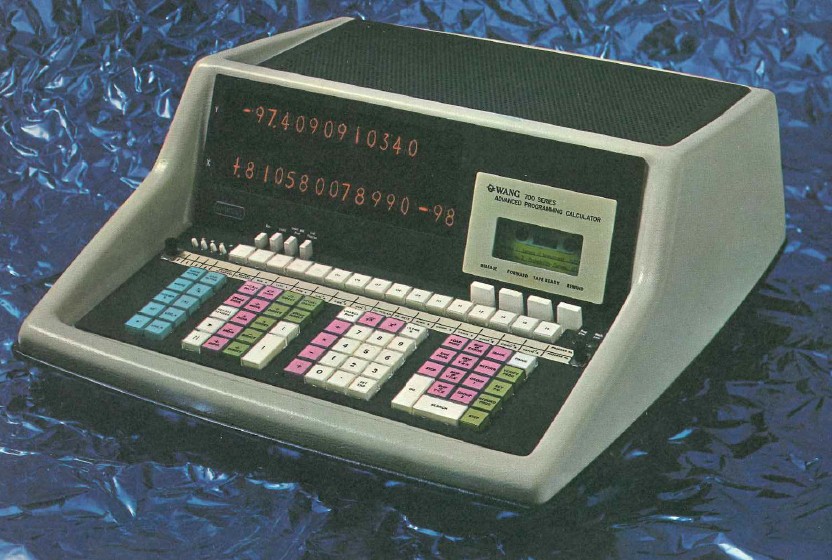
The Wang 700 looked a lot like the Wang 500 in general appearance; it came out shortly before the Wang 500, and while it had logarithmic functions, it did not have trigonometric functions. It did, however, include several keys for doing indirect operations, and was billed as a more powerful calculator than the Wang 500.
Its most notable difference, however, is that its display contained two numbers, and they were shown to twelve digits of precision instead of ten.
I do have a color photograph of the Wang 700 available, and so it is shown at left.
Thus, the introduction of the INDIR key on the Wang 520 gave it the best of both worlds, so that one would neither be giving trigonometric functions up to get indirect addressing, nor giving indirect addressing up to get trigonometric functions.
An option was available for the Wang 700 to give it the capability of calculating trigonometric functions, but those calculations were slower than with the built-in trigonometric functions of the Wang 500 and 600 calculators.
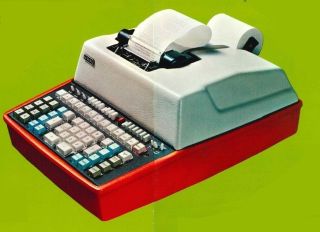
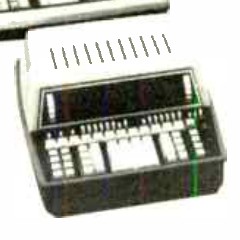
Dr. An Wang's company made many other models of calculator. After the Wang 600, a smaller calculator with similar capabilities, the Wang 452, was introduced; it was implemented with integrated circuits. But it came out in 1972, the year the HP 35 pocket calculator arrived, and thus, with the writing on the wall so clearly visible, the company moved to making computers and word processors. Slightly earlier were the Wang Series 100 calculators, one model of which is shown at left, which was similar, but required an external card reader to be programmed. The model shown on the left has a printer but no display; another model with a display but no printer is shown at right.

Perhaps also deserving of a mention here is the unique Casio fx-3 calculator from 1975, pictured at right.
The reason it is unique is on the left side of the calculator; there are five buttons which can be given one of five different sets of five functions; a slider switch, which selects which set of functions is given to them, also rotates a drum on which the functions are printed.
Of course, these days, one would place the buttons below an LCD screen instead, and indicate the functions of the buttons by displaying them at the bottom of the screen, and a number of calculators do that, so as to provide many functions while limiting the number of buttons.
But it is impressive that one calculator was given a multitude of functions back when that sort of thing was not yet convenient.
In 1977, after the microcomputer era had already started, Texas Instruments came out with a desktop calculator of its own, the SR-60, pictured below.
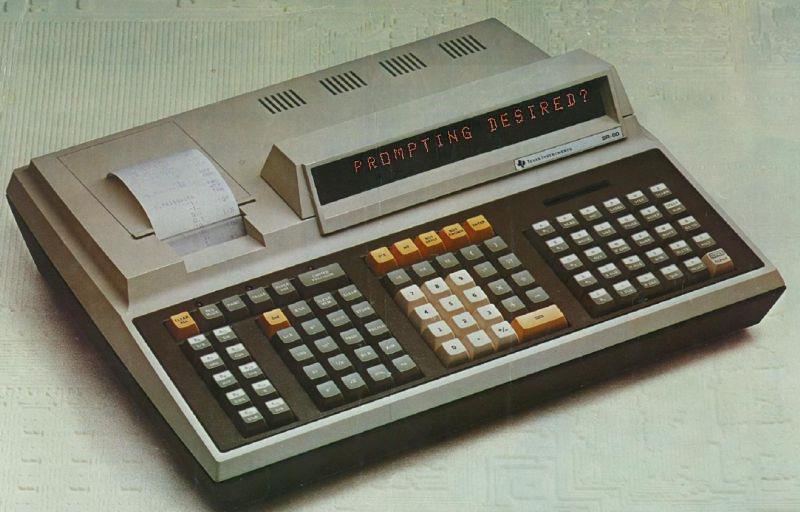
It came with memory for 480 program steps, the same as the later TI-58 handheld programmable, but it could be expanded to 5760 program steps. Aside from more memory, and a built-in printer, it could provide text prompts when requesting input from the user, having a 5 by 7 dot matrix LED display. Eventually, of course, even that feature would be offered by the HP-41C calculator.
It even used the same calculator CPU internally as TI's other pocket calculators, so programs wouldn't run faster than on the SR-52. So it seems to be underwhelming, and also not all that attractive in appearance. But features that other calculators would later offer would still have been features no other calculator had at the time of its introduction, to be fair.
And, as they say, "even Homer nods"... later on, Texas Instruments came out with the amazing TI-92, the one that did symbolic integratiion, and so at that point, all would have been forgiven.
Science fiction is known for predicting some future technical achievements in advance. Rockets that can travel through space, explosive weapons of immense power, and so on. Some things we do not yet have appear often within science fiction; time machines, spaceships that can travel to other solar systems faster than the speed of light, and so on. But less dramatic advances, or advances less amenable to a dramatic plot, are seen much less often in science fiction.
So, when the Altair 8800 ushered in the era of the personal computer, many people asked why this had never been anticipated by science fiction. But this wasn't entirely true.
In 1965, "How to Murder Your Wife" was a comedy movie starring Jack Lemmon and Virna Lisi. When people started asking AI assistants, such as Apple's Siri, for advice on such matters, however, action needed to be taken to prevent them from possibly materially assisting in serious crimes. And this was noted in the news. When that happened, I recalled that this was a situation science fiction had anticipated, in the story "A Logic Named Joe" by Murray Leinster, originally published in the March 1946 issue of Astounding Science Fiction.
And ten years before the HP 9100 calculator, Isaac Asimov's story, "The Feeling of Power" was published in the February 1958 issue of Worlds of If. Its premise was a future era where people became so dependent on pocket calculators that they forgot it was even possible to do arithmetic by hand.
The year 2007, in addition to being the year in which microprocessors made on a 65nm process were introduced (see below for the significance of that process node), was also the year when another pocket-sized electronic device made its debut: the original Apple iPhone. There were competing smartphones brought out before the year ended, but these used the Windows Mobile operating system; Android did not make its debut until the next year, on the HTC Dream. That smartphone had a display that slid to the right to reveal a keyboard (although when the phone was turned to allow use of the keyboard, the direction in which the display had been slid would have become upwards), making it different from the typical smartphone of today.
Before jumping to microprocessors, one other event of note should be mentioned here.
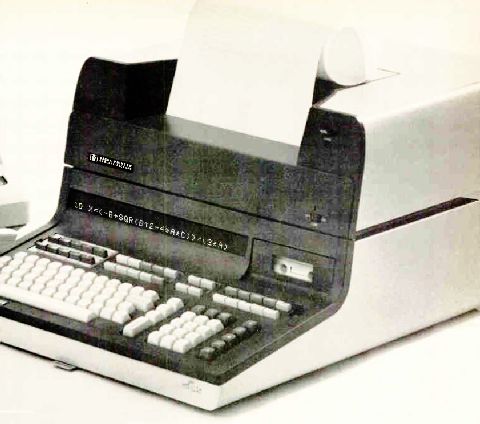
In the December 1972 issue of the Hewlett-Packard Journal, the HP 9830A was announced. An image is shown at right. Although billed as a calculator, it had an alphanumeric display of 32 characters (which scrolled horizontally to allow an 80-character line to be viewed with it) using the 5 by 7 dot matrix, it could be fitted with an optional 80-column thermal printer, it had a typewriter keyboard (basically in the upper-case ASCII pattern, although the @-sign was hidden as the shift of the RESULT key, and the characters [, \, ], ^ and _ were not entered as shifted letters so that the keyboard could be used for lower-case text) - and it could be programmed in BASIC.
It could also be used like a calculator as well from its numeric keypad.
Thus, even before microprocessor-based computers became available, a self-contained desktop unit that could be programmed in BASIC was available. Of course, if one was willing to put up with having two boxes - a minicomputer and a terminal - a PDP-8/e (or even a PDP-8/S) with an ASR-33 Teletype would fit on a normal desk as well, but while it was in some senses an evolutionary step instead of a revolutionary one, I think it's legitimate to view it as a milestone.
Incidentally, although its internal processor had commonalities with the design used in the HP 211x minicomputers, it was still significantly modified because its primary arithmetic capabilities revolved around operations on single decimal digits for calculator operation. And, as a result, the floating-point numbers on which the computer worked were like those offered by a typical scientific calculator: twelve decimal digits of precision, and a two-digit signed exponent.
I would be inclined to view the HP 9830A as the "first personal computer", since other candidates that came much earlier, like the KENBAK-I and SIMON, were really devices for demonstrating how computers worked, and so their purpose was to teach people how computers worked; whereas the 9830A was directly useful for solving problems that required the aid of a computer.
Another computer with a single-line display was the Olivetti P6060; it had a printer built in, and was the first microcomputer with a built-in floppy drive. It dated from 1975; I remember seeing ads for this computer in BYTE magazine; it turned out they were in earlier issues than I expected, with the units being sold at or near their full price, not as heavily discounted surplus. Here's a color photo from a brochure:
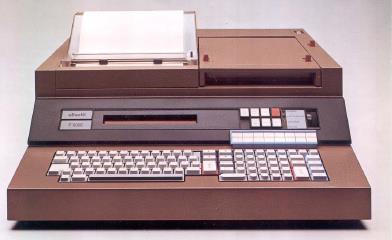
Also predating the microprocessor revolution, the PDP-11/05 and PDP-11/10, which were very compact minicomputers, basically two different designations of the same model, were introduced in June, 1972. In October, 1972, the GT40 terminal, using a PDP-11/05 to control a vector display, was introduced. This was also a single unit that sat on a desktop which had the power of a computer, although it was usually used only as a graphical terminal.
Somewhat later, but still before the microcomputer revolution started in earnest, in September of 1975 IBM introduced the IBM 5100, which could use BASIC or APL or both. To run BASIC, it emulated a System/3, to run APL, it emulated a System/370, and both of those computers were emulated using two levels of microcode, leading to the machine being slow, but that technique did limit the complexity needed for the hardware of the physical CPU. Here is an image of this computer from an early advertisement:

One could choose to purchase a 5100 that could run BASIC, or APL, or both. The switch for selecting between BASIC or APL could also have a third setting, allowing the IBM 5100 computer to act as a data terminal as well. Initially, during development of the IBM 5100, it was intended to use the APL/1130 interpreter on the machine, and thus to emulate an IBM 1130 computer rather than a System/370. However, the decision was made to change this when APL/1130 was found to be unsatisfactory for the purpose. The prototype of the IBM 5100 at the Smithsonian Institution has this version of the APL capability.
Sometimes, the IBM 5100 is unfavorably compared to the HP 85, which also used a cartridge tape and had a CRT and keyboard built in, as the HP 85 was about one-fifth the price; however, as the HP 85 was introduced five years later, that just reflects the rate of progress in microcomputers. Of course, HP also made a product that pre-dated the IBM 5100, the HP 9830A mentioned above.
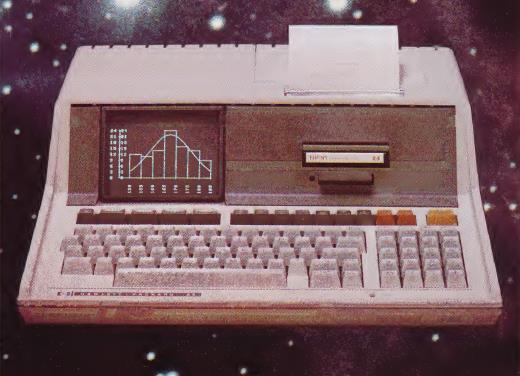
Although it comes after the Macintosh in chronological order, as it is related to the other systems on the page, it is still pictured here on this page, at left. Note that it uses the smaller version of the same kind of cartridge tape drive as was used by the IBM 5100, and that a thermal printer is also included as part of the unit.
The HP 85, and its successors, the 86 and 87, also used a somewhat unusual CPU. The custom chip, code-named Capricorn, performed decimal floating-point arithmetic like a calculator, rather than only supporting binary arithmetic, and then converting the results for display. This avoided some disconcerting results from the rounding of fractions. Of course, that makes it similar to the earlier HP 9820A shown above.
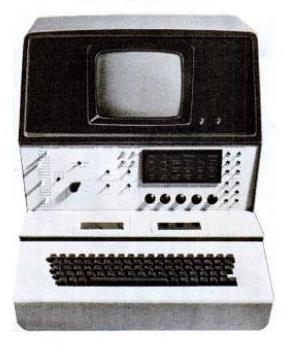
In the first few months of 1970, readers of Datamation magazine would have noticed multi-page advertisments in the last pages of the magazine from a company by the name of Viatron, announcing a revolutionary new product.
The firm was founded in 1967, by engineers from the Mitre Corporation, a non-profit think tank giving support to the national security of the United States, who saw the potential of Large-Scale Integration (LSI) to bring down the cost of computers. They designed the System 21 intelligent terminal, pictured at left, and a 16-bit minicomputer, which made use of LSI so as to be offered at an unprecedented low price.
Unfortunately, while a few systems were made and sold, on the one hand, unanticipated difficulties limited the scale of production, thus preventing or at least delaying profitability, and, on the other hand, delays meant that by the time production would be possible, the system would be eclipsed by designs based on the 8008 microprocessor, or even later ones, although the company's bankruptcy took place in 1971, before this would have arisen.
The term microprocessor, as it happens, was originally coined by Viatron, for their multi-chip designs based on LSI; although they weren't single-chip CPUs, they did use far fewer chips than CPUs required before LSI, so they felt the name was warranted.
AMD today is known for making home computers more affordable by providing Intel with competition, thanks to its history as a second source for the original 8086 chip.
But before that, one line of products it offered was the 2900 series of bit-slice chips. These chips could be used to build a computer from a limited number of components, since each die contained a significant portion of a computer's circuitry.
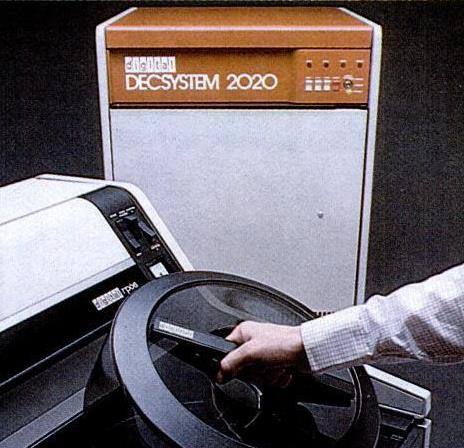
One example of a computer made with components from the Am2900 series is the DECSYSTEM 2020 from the Digital Equipment Corporation. Shown at left, this smallest system in the DECSYSTEM-20 line was built around the KS-10 chassis instead of the KL-10 chassis, and included both bit-slice ALU chips and bit-slice register file chips in its circuitry, allowing this mainframe computer compatible with the PDP-10 to be sold for $140,000 when it was first offered in 1976.
As we saw above, the HP-35 scientific calculator was announced in February, 1972.
It has recently came to my attention that from August 2, 1972 to August 11, 1972, there was intense solar flare activity, with a particularly large solar flare on August 4th.
It was revealed much later that mines laid by the U.S. Navy around North Vietnam were detonated by this phenomenon.
A recent scientific paper concerning this event has made the claim that it was comparable in intensity to the famed Carrington Event of September 1st and 2nd of 1859.
One thing that didn't happen in August of 1972, of course, was for every HP-35 calculator in existence to have been fried. The HP-35 was an impressive technical accomplishment for the time, and so its integrated circuits, supplied (in slightly different versions) by both AMI and Mostek were no doubt in the most advanced integrated circuit process then available, which would have been a 10 μm process.
Thus, if the 1972 event was indeed comparable to the Carrington Event, we now have a benchmark which tells us that we will not need to build computers out of vacuum tubes in order that they may survive such an event; the use of early MOS circutry built on a 10 μm (or 10 micron) process will suffice.
An important technical advance much used during this period, but which is sufficiently obscure that I only recently learned of it, is Four-Phase Logic. This was invented by Robert K. Booher in 1966, and was utilized by his employer, Autonetics, which we earlier encountered in these pages in connection with their RECOMP II computer, in their D200 airborne computer.
This involved designing logic circuits with four clock signals, in two pairs that did not overlap, making use of capacitance in the wires connecting transistors to retain signal levels. This technique was claimed to allow the early MOS integrated circuits to achieve ten times the packing density and speed, and one-tenth the power consumption, otherwise possible with conventional digital logic techniques.
I have since learned what I think is the main reason for these gains. In early MOS digital circuitry, logic gates required an output transistor to operate in the expected manner, with the output signal continuously remaining in the state corresponding to the desired function of the input signals. The output transistor accounted for a large part of the current consumption of the logic gate.
Four-phase logic, being a dynamic logic technique, allowed the output transistor to be dispensed with, reducing both power consumption and transistor count. It allowed the logic circuitry to be clocked in such a way that the behavior of logic gates without output transistors no longer prevented it from functioning, as, essentially, the output of the logic gates was only used when it was correct.
As it happens, the story of Autonetics comes full circle in a strange way as well.
The technique of four-phase logic inspired one computer company to take the name Four-Phase Systems. Using four-phase logic, it designed custom chips for use in its computers, including an early bit slice chip that was 8 bits wide.
The computer they made with that chip, the System IV/70, had a 24-bit word length. And it had floating-point instructions.
Single-precision floating-point numbers on that system were 48 bits long. The first word contained a 24-bit two's complement signed mantissa (called the fraction) and the second word contained a 24-bit signed two's complement binary exponent.
These numbers were required to be aligned in memory on 48-bit boundaries.
Double-precision floating-point numbers were 72 bits long, or three words. The first word began with a zero, which was followed by the 23 least-significant bits of the fraction. The second word contained the 24 most-significant bits of the fraction, which again was in signed two's complement form, and the third word contained the signed two's complement binary exponent.
Double-precision floating point numbers had to be stored starting in a word at an odd address, so in arrays they took up 96 bits of space, with every fourth word being unused.
Thus, in the Mark IV/70, the exponent range was 10 to the power of +/- 2,525,223, which is a very large exponent range by usual standards, as a consequence of making the exponent a full word in length in order to keep floating-point arithmetic fast and simple... just as was done in the RECOMP II computer. So it incorporated two ideas that came from Autonetics; the new innovation of four-phase logic, and the early uncommon characteristic of floating-point numbers with a full-word exponent to allow the provision of hardware floating-point on the cheap with little if any specialized circuitry!
And I have not yet mentioned the most significant historical aspect of the Mark IV/70. It was on November 15, 1971 that Intel made the 4004 microprocessor available to the world. But the Mark IV/70, which had a CPU on a small number of chips, if not a single chip, was announced at the 1970 FJCC, and Wikipedia notes that a few were in use on customer sites by the summer of 1971.
Thus, it could be held to be the first fourth-generation computer known to the public, even if one does not wish to count a bit-slice system as a microprocessor.
The qualification up above is not just for show. The F-14A fighter jet used by the U. S. Air Force had a computer, the Central Air Data Computer, the Garrett AiResearch MP944, which resided on a small number of chips. One was the main CPU; there were two additional chips for multiplication and division, which were optional; but some essential CPU functions were in a second chip - the program counter was placed in the system ROM chip, and instead of the basic ALU for addition and subtraction being in the CPU, one was placed in each of the Data Steering Units, of which the system used three; the main CPU, called the Special Logic Function, was in one module, the Parallel Multiplier Unit in another, and the Parallel Divide Unit in a third; each module had its own Data Steering Unit, its own RAM, and its own ROM.
This allowed the computer to perform some operations in parallel, enhancing its speed. It operated on 20-bit binary integers.
A system like this generally is called a microcomputer, and it predates the Mark IV/70 by several months. But it was not declassified for many years afterward.
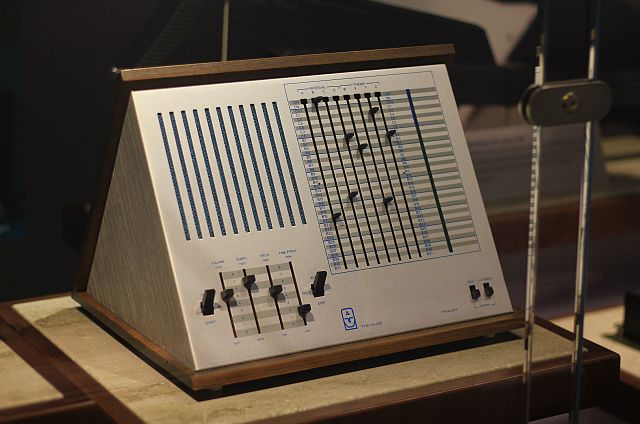 |
The image above is from Wikimedia Commons, licensed under the Creative Commons Attribution 2.0 Generic License, and is thus available for your use under the same terms. Its author is Michael Hicks. |
At left is a photograph of a Triadex Muse on exhibit at the Computer History Museum. Invented in 1969 by artificial intelligence pioneers Marvin Minsky and Edward Friedkin, it would generate and play melodies which varied based on the notes selected in the eight slider switches shown on the right of the device.
While it used fairly simple circuitry to perform this task, when it was offered for sale at the price of $300 in 1972, it generated a considerable amount of attention.